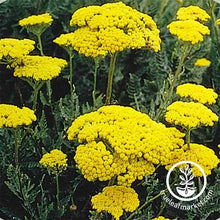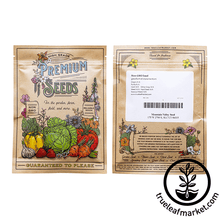2nd Year Maturity. Golden yarrow achillea seeds grow one of the most classic and familiar blooms native to most of the northern hemisphere. Achillea is a vigorous outdoor favorite for adaptable, brilliant seasonal color to accent any flower bed, porch, patio, or planter. Golden yarrow seeds promise summer-hardy 18 – 24” vibrant yellow achillea shrubs, most popularly grown and treated as a wildflower. Golden yellow achillea is easy to grow from seed and a perennial performer in a variety of gardens prone to heat, drought, and poor soils.
Growing Golden Yarrow Achillea Garden Seeds
- Taxonomy: Achillea filipendulina
- Other Names: Gold Plate Yarrow, Common Yarrow, Fernleaf Yarrow, Soldier's Woundwort, Old Man's Pepper, Thousand Leaf, Devil's Nettle, Sanguinary, Bloodwort
- Seed Type: Perennial
- Sow Indoors or Outdoors: Golden yarrow achillea seeds have a wildflower-like hardiness and are most commonly broadcasted directly outdoors after the frost, with little reason to ever sow indoors. Evenly rake and tamp broadcasted seeds into soil. If sowing traditionally, plants will need protection against the wind. Once established, yarrow may aggressively reseed itself and remain in the garden for as long as you'll have it around.
- Days to Maturity: 2nd Year Maturity
- Hardiness Zone: 3 – 8
- Planting Depth: Lightly press 7 – 8 seeds into soil or broadcast directly
- Plant Spacing: 12"
- Growth Habit: 18 – 36" tall weedy upright with an 18 – 36" spread bursting with floreted clumps of countless tiny blooms
- Soil Preference: Loamy, medium dry, well-drained
- Light Preference: Full sun
- Diseases/Pests/Troubleshooting: Golden yarrow achillea is a sun-hardy perennial known to tolerate drought and poor soils. Plants are susceptible to rust, stem rot, and powdery mildew if grown in poorly drained and saturated soils. Yarrow is listed by the USDA as being an invasive species and may aggressively reseed itself by both seeding and rhizomes.
- Color: Golden yellow florets with vibrant greens
-
Seeds Per Package:
- 1/4 oz - Approximately 43,500 Seeds
- 1 oz - Approximately 174,300 Seeds
- 4 oz - Approximately 697,500 Seeds
Golden yarrow achillea seeds have a wildflower-like hardiness and are most commonly broadcasted directly outdoors after the frost, with little reason to ever sow indoors. Evenly rake and tamp broadcasted seeds into soil. If sowing traditionally, plants will need protection against the wind. Once established, yarrow may aggressively reseed itself and remain in the garden for as long as you'll have it around. Lightly press 7 – 8 Golden yarrow seeds in loamy, medium dry, and well-drained soil in full sun. Golden yarrow achillea is a sun-hardy perennial known to tolerate drought and poor soils. Plants are susceptible to rust, stem rot, and powdery mildew if grown in poorly drained and saturated soils. Yarrow is listed by the USDA as being an invasive species and may aggressively reseed itself by both seeding and rhizomes. White yarrow is a perennial that matures in its 2nd year as an 18 – 36" tall weedy upright with an 18 – 36" spread bursting with floreted clumps of countless tiny golden yellow blooms.
Achillea filipendulina, or more commonly known as yarrow, is native to many regions in the Middle East, but has since naturalized throughout many moderate and arid climates throughout the northern hemisphere. The genus Achillea is named after the Greek hero Achilles, who is said to have treated his wounded soldiers with the plant. Yarrow is toxic to animals, however it has proved medicinally useful to humans for various ailments such as skin rash, nausea/vomiting, and as a fever reducer. Yarrow works well in a lot of DIY tea blends because it is a well-known blood coagulant. It does wonders for nosebleeds and heavy menstrual cycles. However, it can be potentially dangerous if taken with blood thinning medications, such as aspirin, clopidogrel (Plavix), and warfarin (Coumadin).



